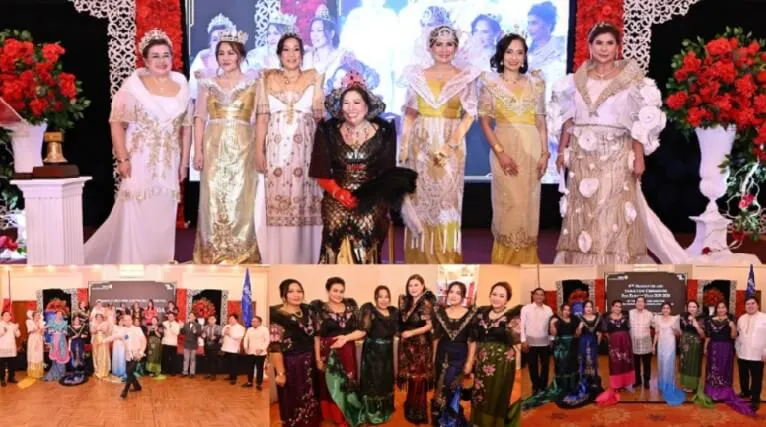
I just took a trip to 1920s Manila, no time machine required, and I didn’t even leave the present! Curious how I managed it? Here’s my story.
Last August 22, I was invited to witness the 9th Handover and Induction Ceremonies of the Rotary Club of Makati Ayala Triangle (RCMAT) for Rotary Year 2025–2026.
The event was held in one of the ballrooms of the historic Manila Army and Navy Club. This century-old edifice was designed by esteemed architect William Parsons and completed in 1911.
Once a gathering place for American officials and Manila’s elite, the building later saw different uses before its 2017 restoration, when it reopened as the Rizal Park Hotel.
While there was nothing wrong with holding a simple and formal handover and induction ceremony, as had often been done in the past, the RCMAT members challenged themselves to take it a step further—this time embracing the glamour and spirit of the 1920s.
And why not? It was their once-a-year event—something everyone hoped would be truly unforgettable. The historic venue called for it, and so did the month.
After all, August is not only National Language Month but also History Month. By weaving in the glamour and splendor of the 1920s, the themed celebration managed to tick three boxes all at once: the occasion, the venue, and the timing.
To truly capture the nostalgia of a bygone era, the members dressed in their finest Filipiniana.
The event started with a lively bodabil performance by the Kalilayan Folkloric Group from Catanauan, Quezon, perfectly setting a nostalgic tone that brought back the charm and spirit of old Manila.
For those unfamiliar, bodabil is a type of theatrical show that was a popular form of entertainment for Filipinos until the 1960s. You can read more about it in my previous article on GMA-7’s period drama series Pulang Araw—go check it out!
Going back to the RCMAT gathering, most men arrived in their barong, while the ladies graced the event in their traje de mestiza.
My personal description of the traje de mestiza is that it represents the evolution of the Maria Clara attire from the turn of the century and serves as the precursor to the modern one-piece terno.
Known for its large butterfly sleeves crafted from airy fabrics like piña and jusi, or other delicate fabrics, the traje de mestiza became the formal wear of choice for women in the late 19th to early 20th-century Philippines, reaching its height in Manila’s 1920s–1930s high society. The sleeves, structured and poised, frame the shoulders with dignity, while the ensemble is completed with a panuelo for refinement and a tapis that serves as a harmonious accent.
The same observation was shared by heritage advocate, Filipiniana designer, and RCMAT member Rommel Padillo Serrano during the event: “Tingnan mo ’yong shoulders. Napaka-dignified,” he said, describing the women on stage in their timeless and truly Filipino garments.
Think of iconic Filipinas of that period: former First Lady Doña Aurora Quezon; women’s rights advocate and Girl Scouts of the Philippines founder Josefa Llanes Escoda; and story writer and educator Paz Márquez-Benítez—all of them exuded uniquely Filipino grace and elegance in their traje de mestiza.
The theme of the celebration would not have been complete without the beloved ladies of early 20th-century Philippines—the Manila Carnival Queens. The RCMAT presidents, past and present—all women—paraded through the hall in their crowns and dazzling queenly attire, a nod to the legacy of these well-loved Filipina beauty queens.
Past presidents Prescy Yulo (2017–2018, 2021–2022), Melanie Omar (2019–2020), Marilyn de Mesa (2022–2023), Cecille Asprec (2023–2024), Tess de Guzman (2024–2025), and Linda Moya (2025–present) gamely joined in the tribute.
Though not exactly as extravagant as the grand spectacles of the 1920s, the moment added just the right sparkle to an already glitzy event.
It was truly a sight to behold—one that radiated grace, pride, and a sense of women’s empowerment.
I saw it as a fitting parallel: the Manila Carnival Queens of the past were not just pretty faces dressed regally in their traje de mestiza. They answered the call of their time, much like the RCMAT presidents and members do today.
The club is known for championing health, education, and, now, including Filipino heritage, with programs that support basic education and literacy for children, improve community health through nutrition and medical missions, and ensure access to clean water and sanitation.
Similarly, in the olden days, many queens became active in charitable works, civic organizations, and education. Some were patrons of the arts and culture, while others lent their voices to local causes.
Most notably, they stood at the forefront of the women’s suffrage movement, becoming symbols of empowerment at a time when Filipino women were still fighting for the right to vote. And they prevailed. Filipinas finally secured that right in the 1937 plebiscite.
Because of what the Manila Carnival Queens did and started, it’s no wonder beauty queens are held in such high regard in our society.
The Manila Carnival Queens were never just symbols of beauty. They embodied intellect, influence, and courage. Their contributions in education, literature, fashion, women’s rights, and civic leadership left a legacy that continues to inspire. Paying tribute to them is only fitting.
Congratulations to RCMAT for a job well done. In a short time, you gave us a glimpse of what life—and a lively party—was like in the 1920s.
As a guest, an observer—or even just a humble salingpusa—the heritage-themed event reminded me not only of our past but also of the timeless lessons it holds, still relevant today.
The 1920s, under American colonial rule, showed us that education empowers (as seen in the Manila Carnival Queens, who came from affluent and educated families), unity fortifies our national pursuit of independence, every voice matters regardless of gender, and that we are a resilient people capable of evolving and keeping pace with the tides of time.
Above all, it reaffirms my belief that we are a nation blessed not only with an eye for beauty but also with the wisdom to channel it toward greater causes. We possess the gift of transforming creativity into purpose—and purpose back into creativity.
We have always known how to combine local and foreign elements to create something distinctly ours. The traje de mestiza, for instance, is the perfect marriage and evolution of Western influence and Filipino artistry.
Similarly, the concept of the Manila Carnival Queens may have originated from an American idea, yet these women used the platform to champion Filipino causes.
This gift of adaptation has always been our strength. We transform what was borrowed (or imposed on us) into something uniquely Filipino. We don’t merely imitate; we reinterpret, reimagine, and reinvent, until what remains is a cultural expression that reflects our collective soul.
And truly, we are a nation of gifted, creative, imaginative people.
Read more Good Travel stories from Atom Pornel here:
- Inside the Colors of Pahiyas: A Celebration of Faith, Heritage, Harvest, and Community | Atom Pornel
- A Cultural Renaissance in Batangas City: The Rise of Talumpok Subli | Atom Pornel
- Cultural Threads: Tracing Traditions from Davao del Sur to South Cotabato | Atom Pornel
Join our vibrant Good News Pilipinas community, where we celebrate the achievements of the Philippines and Filipinos worldwide! As the Philippines’ No. 1 Website for Good News and proud winners of the Gold Anvil Award and Lasallian Scholarum Award, we invite you to connect, engage, and share your inspiring stories with us. Together, let’s shine a spotlight on the stories that make every Filipino proud. Follow us on all platforms through our LinkTree. Let’s spread good news and positivity, one story at a time!










